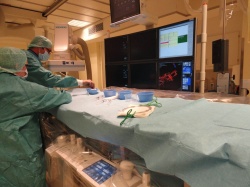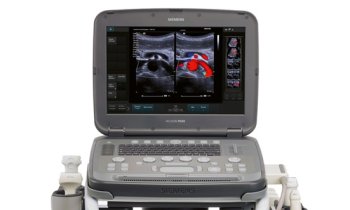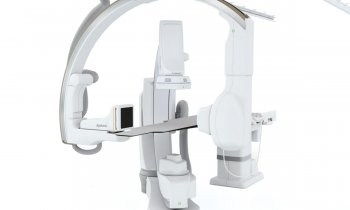Stroke treatment
Six international studies endorse thrombectomy
Results from six international randomised controlled studies conclusively and uniformly confirm, for the very first time, the effectiveness of thrombectomy in patients with acute, severe ischaemic strokes caused by a blood clot in one of the proximal cerebral arteries. The endovascular procedure is an add-on to conventional thrombolysis. EH reports from a German Stroke Society (DSG) press presentation held this May in Berlin.
Report: Bettina Döbereiner

The interventional procedure of endovascular recanalisation, in short thrombectomy, for acute severe ischaemic strokes, is not new. With this procedure, which has been carried out worldwide for several years, the occluding blood clot is mechanically removed with the help of a so-called stent retriever – a micro-catheter developed only quite recently – which is guided to the cerebral artery from the femoral artery.
The procedure is carried out in addition to the administration of thrombolytic medication within the first six hours of the start of symptoms and facilitates recanalisation, which cannot always be achieved with thrombolysis alone (general recanalisation rate in severe strokes around 35%) – particularly for clots >1cm (recanalisation rate for thrombectomy around 80%).
Until now no studies could prove the benefit of the endovascular recanalisation for patients with regards to lasting disabilities and mortality compared to the conventional procedure of intravenous thrombolysis. However, this has now changed.
‘We now have the certainty, for the first time, that if this procedure is used in a specific and systematic way, our patients experience fewer lasting disabilities and lower mortality at three months after the procedure,’ said Professor Matthias Endres, Director of the Clinic for Neurology at the Charité University Hospital in Berlin, Germany and Deputy Chairman of the German Stroke Society, during its related press presentation.
The first of this round of six studies that recently scientifically confirmed the benefit of thrombectomy was the Dutch MR CLEAN study presented at the World Stroke Congress in October 2014. This showed that the functional independence rate which scores how patients can independently cope with their daily lives 90 days after the procedure (modified Rankin score 0-1) was 13.4 percentage points higher in patients who had received an additional thrombectomy compared to the control group where patients only received thrombolysis (32.6% vs. 19.1%).
The following five studies were all terminated early because their preliminary results were, in some cases, significantly higher still than the results of the MR CLEAN study. The continuation of the studies would not have been justifiable for ethical reasons. The first three of these studies – presented at the International Stroke Conference in Nashville, USA in February this year (EXTEND-IA, ESCAPE 2, SWIFT-PRIME) – confirmed that the chances of patients achieving a favourable treatment outcome through thrombectomy were 20-30% higher overall than those of patients in the control group, Endres said.
Patients’ independence was maintained more frequently, as confirmed in the EXTEND-IA study: 90 days after the stroke occurrence almost twice as many patients could lead their lives without any functional impairments (71 vs. 40% ) compared to the control group. Mortality was also considerably reduced from 19% to 10.4% in one study (ESCAPE). These results were also confirmed by the results achieved with the REVASCAT and THERAPY studies so far, which were presented at the European Stroke Organisation Conference in Glasgow in April this year, with some minor deviations attributed to the design of the studies.
Professor Bernd Eckert, Head of the Department for Neuroradiology at the Asklepios Clinic in Altona, essentially attributes the positive results of the new studies to the utilisation of modern, cranial imaging procedures as the basis for precise patient selection, and, in particular, to CT angiography (vs. unenhanced CT as in the 2013 studies), and overall also to considerably shorter processes and the predominant use of modern stent retrievers (see image 2).
The rate of complications for a thrombectomy compared to the rate of complications for alternative procedures is relatively small and in view of its large benefits negligible, Endres and Eckert said. One possible complication is that a blood clot floats upwards. New procedures that produce a vacuum in the carotid artery when the catheter is removed could lower the risk to below 5% of cases, Eckert said. A further risk lies in the fact that blood vessels may be damaged or burst while the catheter is being guided, resulting in bleeding. However, said the neurologist, ‘studies show that this risk, at 3%, is comparatively low in experienced hands.’
Thrombectomy as acute therapy is suitable for only 5-10% of all patients who have suffered an ischaemic stroke, said Endres. In Germany this corresponds to at least 11,000 patients a year. Ischaemic stroke caused by a blood clot must be confirmed in the proximal cerebral arteries and the patient must be treated no later than six hours after symptoms first appear. The extent of irreversible damage suffered must be low and there must be saveable ischaemic tissue for thrombectomy to be effective.
Germany is not alone in preparations to continue to offer high quality thrombectomy to all patients who would benefit from it is, based on the scientific evidence of the effectiveness of the procedure. The European Stroke Organisation, European Society of Minimally Invasive Neurological Therapy and European Society of Neuroradiology are already working on respective updates of their guidelines. Up till then, the Consensus statement on mechanical thrombectomy in acute ischaemic stroke, jointly published in February this year, will continue to be the binding recommendation for the use of this procedure.
22.06.2015











